Feed management can be a challenging task, especially if you are responsible for several feeds at the same time. All online retailers make mistakes from time to time, but there are many pitfalls that you can easily avoid if you are just aware of their possible occurrence.
In this article, you can find out 12 of the most common mistakes online retailers make, so you can be the one to stay away from them.
Read on and don't waste any more of your time or advertising budget.
1. Leaving feed management up to the IT team
Many companies still have to rely entirely on their IT department to create, optimize and manage product feeds. And what does this kind of feed management look like?
- Any change to the product feed is likely to take days or even weeks for an IT department.
- You need to send a separate request to your technical team for each feed optimization or small change, such as excluding some products, adding new items to the feed or creating custom labels.
- As a PPC manager, you cannot systematically optimize your feed based on the daily results (e.g. react quickly and remove unprofitable products).
Reduced income potential is the price to pay for this kind of feed management. The time it takes to make changes through the IT dept. often prevents advertisers from taking advantage of time-sensitive opportunities.
The solution
Moving your data feed operations over to a Feed Management Platform not only solves the timeliness issue, but also allows businesses to put the power of data in the hands of marketing experts or PPC account managers.
The most important advantages of leveraging a data feed software:
- You gain independence in feed management
You gain control over rapid introduction and implementation of new ideas and testing. You have direct access to product-level data, and you can make quick updates based on it.
- It is a performance-booster for your campaigns
You will be able to tailor the data to your goals and take into account your potential challenges. In this way, the data will best support your campaign objectives.
- You save a lot of time
Simple optimizations can be performed at high speed. It only takes a few minutes. And, you don't have to wait for a "yes" from other teams.
- You save money
Fewer people, departments and teams involved in feed management means less budget spent on feed management. That way, you have more money for other activities.
2. Using the same feed for every channel
Many retailers start out their online advertising journey with just one channel and one data feed. When ready to expand, they try to use the same feed on other platforms and in different destinations.
Successfully managing campaigns on different channels and in different countries often requires a tailored approach. Using the same data feed for multiple channels may lead to listing errors and lower your product visibility significantly. That is because each ad platform has its own requirements, a different ad build structure, and more importantly - a different intent of the audience.
In Google, for example, customers focus a lot on titles that tell them whether the particular product is exactly what they are looking for.
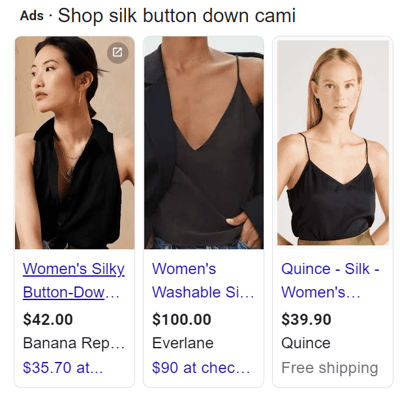
In the example of an Instagram ad below, you can't see much more detail than the image. It takes shoppers' full attention.

Having that in mind you may want to focus on keywords in product titles when listing on Google, but focus primarily on optimizing images when sending products to Instagram.
The Solution
To avoid potential product disapproval or wrong optimization approach, you should have a separate product feed for each platform of your choice. You can achieve this easily by deploying a feed management solution that offers multiple channel integrations. It will allow you to quickly prepare as many data feeds as you need, so that each of them meets the requirements of each advertising channel individually.
What makes it easy to create feed in a feed tool is that:
- All the requirements that a specific channel has (file format, required and recommended fields names etc.) are pre-loaded in templates. This ensures that you don't do anything wrong like entering a non-acceptable value or forgetting to map a mandatory field.
- The tool will auto-correct most common errors such as capital letters in your titles.
- You can make instant changes to each of your feeds individually without impacting other channels
- More about the benefits of using a feed tool in this article.
3. Using the same product set for every channel
What works on one channel may not work on another. In fact, each channel has a different target audience with a different purchase intent. That's why it's not always good to use the same set of products across all sales channels.
A good example here is the difference between search-based channels and social media when it comes to which products sell well.
On Google and other search channels, people actively search for specific products in a particular size, color, brand, etc. On social media like Facebook and Instagram, shopping is usually not their primary intention. And that should be taken into consideration when deciding which products to feature on each.

Excluding items from the feed | DataFeedWatch
The solution
Below are a few examples of how you should go about deciding product sets for specific channels.
- Product variants vs. parents products only
On Google, most users search for a very specific product, for example “Nike air force 1 low black size 46”. No one on Facebook is browsing after something that specific. Now, you can probably see that it's worth advertising variants on Google Shopping and parent only products on Facebook.
Check our article on that topic: Should you include variants and parent products in your data feed?
- Niche products, art products, eye-appealing products
Niche products can often be hard to sell and therefore difficult to find in normal online stores. But they can inspire Facebook, Instagram or Pinterest users.
Any art products that are visually appealing are also a perfect match with social media. People are very receptive to external stimuli - if they like what they see on social media, they are likely to be willing to buy it.
- Products of high complexity
Technically advanced products with many specifications will not be suitable for social channels. People usually use one of the search channels to find, for example, a good laptop.
4. Updating the product feed only once a day
Some retailers who only sell a few products don't need more than one daily update. But if you run extensive multi-product campaigns every day, it's different. Your products' availability status can change very quickly and one update daily may not be enough to keep your ads up-to-date. It would take long hours for your customers to see that the particular product is no longer in stock, for example.
Advertising products that are out of stock means that your advertising budget is completely wasted. Plus, it just creates a bad customer experience.
The solution
You should set up multiple daily updates to stay competitive and give your customers a better streamlined online shopping experience.
- Out-of-stock products
Multiple daily updates will ensure that your ads always reflect your latest product availability (quantity of the certain products). You won’t be “selling” out-of-stock items.
- New items
With multiple feed updates you can add new items to your inventory during the course of the day and the changes will be visible almost immediately.
- Hourly special offers
You may offer hourly special offers to your customers. Frequent daily feed updates allows you to reflect that in your product ads.
- Staying competitive
If you notice some big price differences between you and your competitor, you may decide that your offers need to be adjusted. Frequent feed updates will help you to implement these adjustments very quickly.
Many feed management tools allow you to set up multiple daily updates (with DataFeedWatch it’s up to 24 updates daily) and ensure that your product data is updated at all times.

Scheduling feed updates | DataFeedWatch
5. Not syncing the feed updates and channel updates
Online advertisers are not always careful about when exactly they set the update in their feed tool and in their advertising channel, for example in Google Merchant Center.
So it happens that they have, for example, a feed update in their feed tool at 10 in the morning and a feed fetch in their channel at 16 in the afternoon. This makes no sense, because your product data may already be out of date at 4pm.
The solution
Make sure that your feed update is set up first and your channel update (for example Google Merchant Center feed fetch) is set to follow right after. The channel update should be set up no more than 1 hour after the feed update, not 6 hours after or so.
To make your life easier you can choose to use FTP connection. This way, your feed is automatically updated in the desired channel when changes are made to it. To obtain FTP credentials and set up a connection, you need to follow the procedure for the specific channel.
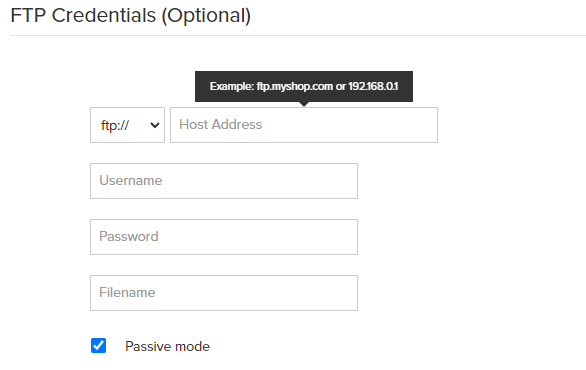
Setting up FTP connection | DataFeedWatch
Once everything is set up, your data feed will be automatically sent to the server every day, just after your products have been updated in a feed tool like DataFeedWatch.
6. Optimizing the product feed separately from the PPC campaign
More and more online retailers know about the importance of feed optimization. But sometimes it can also go wrong. It happens when you optimize the feed without taking into account the purpose of your PPC campaign or its current performance.
Setting campaign goals should never be separated from deciding and implementing feed optimization tactics. It should be your compass in choosing the feed optimization strategy that supports the same goal.
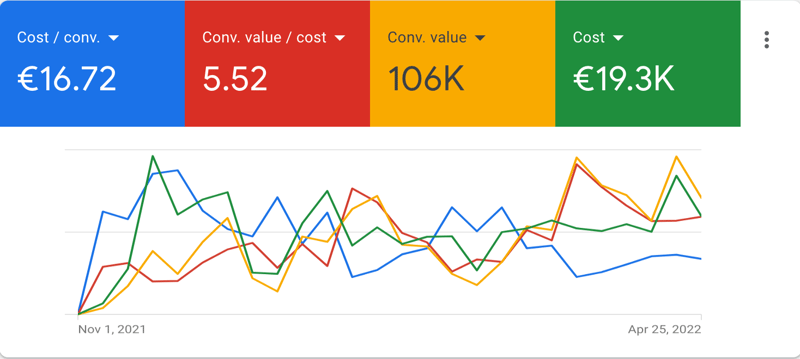 Example results from feed optimization when aligned with the campaign.
Example results from feed optimization when aligned with the campaign.
The solution
To achieve the kind of results you wish, it is crucial that you take care of both full feed optimization and strategic campaign management.
So the main motto should be: Know your goals when optimizing your data feed!
- You want to increase the conversion rate of your ads.
If your primary objective is to increase the conversion rate of your ads, you might consider a feed tactic such as creating ads labels and prioritizing the products that are on sale.
- You want to drive more ad traffic.
You might try a duplicate ID tactic. This hack allows you to duplicate product IDs within the feed and diversify the product titles for each copied product. As a result, you can run multiple ads of the same product, each with a different title.
- You want to optimize your ad spend
You might try excluding unprofitable products from your feed. You can also segment your products and adjust your bidding strategies based on margin, for example.
These are only a few examples, but the list goes on. If you remember to optimize your feed with PPC campaign goals in mind, you will get many benefits such as:
- Lower CPA
- Better ad position
- Better CTR
- Achieving your campaign goals
7. Including only the mandatory product attributes
Each advertising channel has its own data feed specification defined. Most platforms like for example Google or Facebook, provide their criteria online, so that everyone interested can easily get familiar with them.
The requirements are mostly about file format and what fields need to be included in the data feed. If you provide the values for all the required fields, your products will be approved and you will be able to run ads on that platform. And some online retailers provide the bare minimum, so all their products are approved, and don't care about anything else. That’s a mistake.
The quantity and quality of data in the feed will affect the success of your PPC campaign.
The solution
The more additional product data you include in your feed, the more likely your product ads will be shown to the right audience. You should add as many additional attributes to your feed as possible.
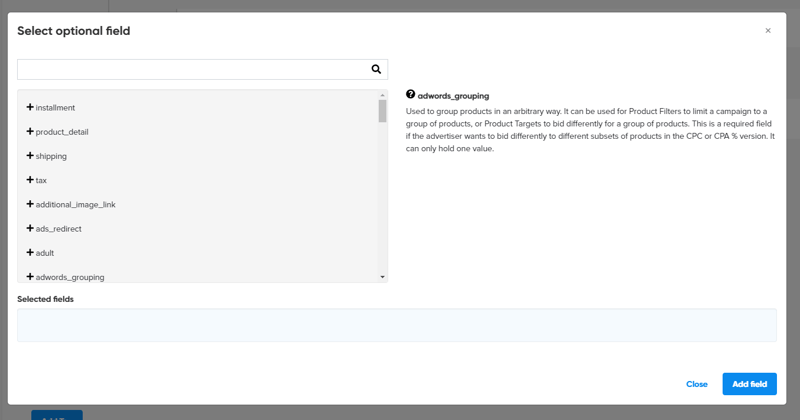
Adding additional fields | DataFeedWatch
Example:
The attribute "gender" is not required, but recommended. If you sell products in the Clothing & Accessories category, you may want to indicate that a particular item of clothing is intended for women/men to avoid wasting your advertising budget.
By making an effort to optimize your product feed, you’ll get lots of benefits:
- Greater visibility of your product ads
- Better targeting
- Up-to-date ad info
- Reduced ad costs
Read more about the importance of feed optimization here.
8. Advertising only parents products because it’s easier
Advertising only parent products in one channel may work well, but in other channels may be a total disaster. Giving up variants in your feed every time because it takes less time and it’s easier is not good thinking. Yet many online retailers follow this approach.
The solution
The right way to do it is that when you choose a channel for your products, you should always ask yourself a question: Should I include variants or only parent products in the feed for this channel?
Sometimes including variants is required and sometimes you should include variants in your product feed - to increase the chances for your products to show for more specific queries.
- More visibility
First, some platforms, like Google Shopping, require you to include all variants in your feed as unique products. But even if they don't, think about it if you're selling fashion, for example:
Your potential customers might be looking for a green jacket. If you don’t include the green variant in your feed, your jacket will never show up for the search queries like that. And many shoppers do include product characteristics such as color and material in their search queries.
- Retargeting campaigns
Including variants in your feed allows you also to be very successful with retargeting campaigns. You should always show the shoppers the exact product variant (the same color, material, size etc.) they were previously engaged with.
- Updated stock information
Advertising variants will also allow you to always show the updated stock information about your products. On Google, for example, the availability information in your source feed is at the variant level, and you can't find that kind of data at the parent level. In this case you would have to spend your advertising budget on products that are not in stock.
9. Using parameters of the parent for product variations
Online advertisers often map their product feed “the easy way” without paying attention to the fact that they have variants. They use the same exact title (parent title) for all product variants, as well as the main image.

Mapping image_link | DataFeedWatch
As a result, in spite of the fact that they offer variants of products, their feed doesn’t reflect that. All variants have the same title, image and other attributes, so in practice they are NOT variants. The shopping ads look exactly the same for e.g. both a red t-shirt size S and a blue t-shirt size L. This is because the values for both "variants" are taken from the parent product.
The solution
What you should do to avoid this pitfall is:
- to assign images, titles and other fields to variant image, variant title and other variant-specific attributes from your store,
- Or, for titles, you may choose to combine product attributes such as color and size with the main product title
For DataFeedWatch users
When mapping a variant image, remember to add a "if not blank" condition in case there’s no variant of this product. Otherwise products that do not have variants may end up with a blank image. See the example rule below. The same logic applies to variant_titles and other variant-specific attributes.

Mapping variant images | DataFeedWatch
10. Re-creating complex data configurations for each feed
In some cases, feed mapping is not easy. You need to create multiple complex rules and figure out a way to achieve your optimization goals. And if you manage more than one data feed, you often have to recreate the same complex mapping for another feed and another. As a result, it becomes twice or three times as time-consuming.
The solution
In you’re using a feed management software, there is actually a good solution to this problem or even two to choose from:
- Creating master rules
When using a feed solution like DataFeedWatch you can store your private collection of feed rules in the tool. Instead of recreating a specific feed rule for each of your feeds, Master Fields enable you to create it just once and then roll it out to any channel you choose automatically. You save lots of time.
You will also be able to add new fields, so you can optimize your feeds even better.
- Copying from the existing channel
You can also reduce the work connected to mapping multiple feeds by using “Copy from Other Channel” functionality. It enables you to copy the same mapping that you already had in one product feed to another feed that you are about to create.

Copying from other channel | DataFeedWatch
11. Not monitoring your competitors
There are many online retailers who are so focused on improving their own products and running their own campaigns that they forget about their competitors. They keep the same product price or increase it without taking into account what other online shops are offering. This kind of approach leads to losing your customers to competitors who have probably done their homework - they have monitored their competitors' prices.
There’s a way to keep track of what your competitors are up to at all times. Based on the following knowledge you will be able to make important pricing decisions:
- Information about products your competitors sell
- The prices your competitors are currently offering
- Information about free shipping
- The number of stores that sell the same product as you do
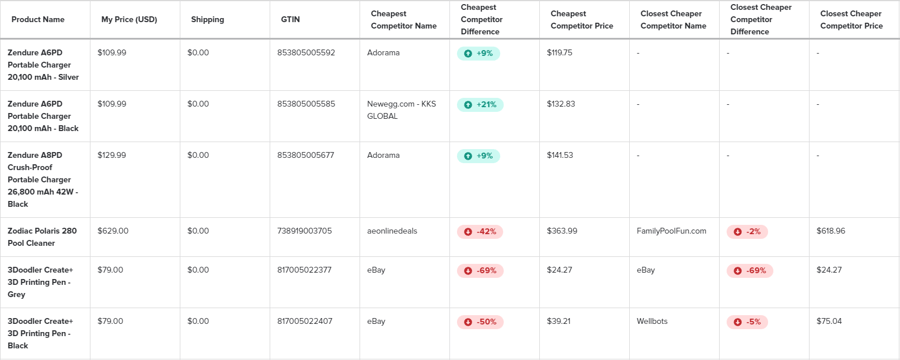
The solution
Include price monitoring in your competitive strategy. There are lots of possibilities for tracking your competitors like Google Benchmarking reports. With pricing intelligence you will be able to collect the pricing data about your competitors and quickly react if you see that your product prices are not matched. The information you get helps you identify the right strategies and tactics to stay ahead of the competition.
Example tactic: If you see that your price for the same product that your competitor is selling is higher than theirs, you can try to reduce your price and compensate for the loss with higher shipping costs.
12. Managing data sources & feeds from multiple places
The last pitfall discussed in this article is not having your feed management centralized. Online retailers or agencies waste lots of time jumping between different systems, accounts or clients to manage multiple data sources and product feeds. It's just inefficient.
In many cases, you need to manage multiple feeds dedicated to many different channels and often for more than one store. You can easily get lost working with so much data stored in different places.
The solution
Store all of your data feeds in one place is possible with the use of a feed management software. When advertising on Google Shopping, Facebook, Instagram and Amazon at the same time, you will see four different channels with different feeds when you log in to your tool.
Another benefit of using such a feed tool is the possibility of using a Multi-Client account.
A Master Account like this one in DataFeedWatch allows you to have one big account with multiple smaller accounts in it. This functionality is perfect for agencies, where account owners can easily switch between client’s accounts.
- You no longer have to log-in and log-out every single time to check the particular account’ status.
- You can give the members of your team different levels of permissions to different accounts and keep control over the project.
It can also happen that your client provides you with not just one, but multiple sources of data from their store, Analytics, Warehouse updating system, etc. A solution like DataFeedWatch allows you to merge all the data sources, so you can get all the product data you need in one place. Then you can edit and optimize it.
Summary
Now you know the most common pitfalls you can fall into when managing data feeds. You also know what you can do to avoid them. Everyone makes some mistakes in their online advertising journey. Why not make fewer?
